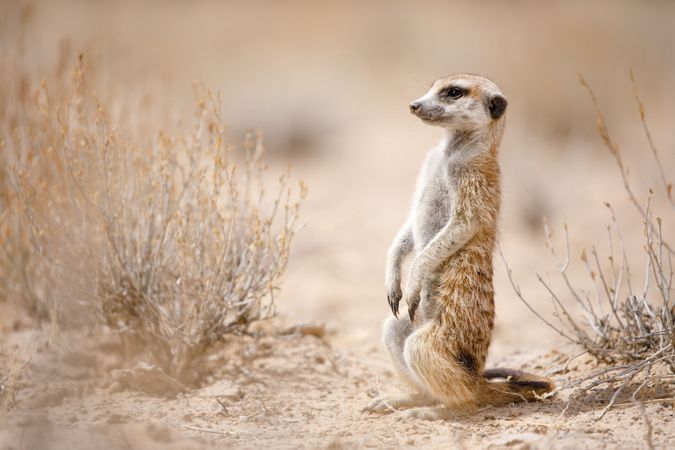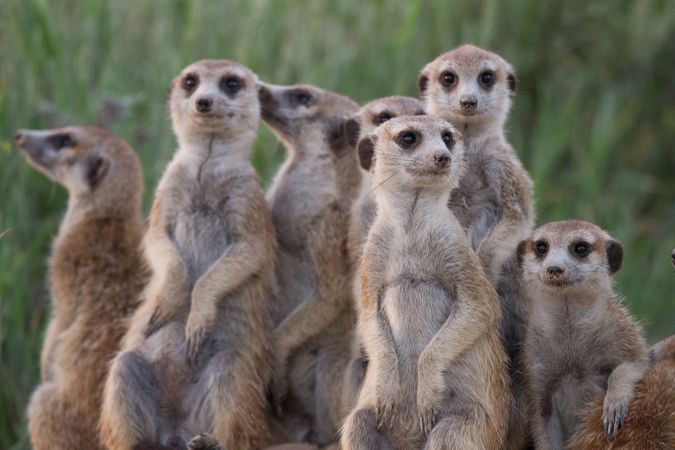
Press release by University of Zurich
The effects of climate change are especially obvious in arid environments where resources are scarce and subject to seasonal availability. However, the demographic mechanisms through which seasonal climate affects population persistence remains mostly unknown. Using detailed monthly life-history data collected by the Kalahari Meerkat Project between 1997 and 2016, scientists at the Universities of Zurich and Cambridge have now assessed how meerkats (Suricata suricatta) will fare in response to future changes in seasonal rainfall and temperature.
Meerkats are cooperative breeders that live in social groups. A dominant female monopolises most of the reproduction, while subordinate helpers assist in raising her offspring. Changes in the physical and social environment affect the growth, survival and reproduction of meerkats. For example, wet and warm conditions at the beginning of summer increase the growth, survival and reproduction of these animals. In contrast, high population densities and cold weather during winter decrease individual growth and survival.
Seasonal dynamics matter
The Kalahari Desert in Southern Africa is projected to become drier and warmer as a result of climate change. The new study investigates how consistently rising summer temperatures and rainfall fluctuations will affect body mass and growth of meerkats, resulting in lower rates of reproduction and offspring survival. However, this isn’t the only finding of the study.
“In addition to the common practice of modelling average annual dynamics, we took a closer look at seasonal dynamics and developed a specific climate change model,” says Maria Paniw of the Department of Evolutionary Biology and Environmental Studies at the University of Zurich. “We found that the picture is more complex: Seasonality matters because improving conditions in one season can partially counter the worsening conditions in the next season.”

Hotter winters can alleviate negative effects
The team linked changes observed in growth, survival and reproduction to changes in seasonal rainfall and temperature. Using these links in a population projection model, the scientists projected the population dynamics 50 years into the future, creating different scenarios based on a report on climate change issued by US National Center for Atmospheric Research (NCAR).
The data shows that the combined effects of hotter and drier summers, in particular, may threaten the persistence of the meerkat population. In the study’s projections, fewer offspring were produced, resulting in fewer helpers in the population. In this scenario, the meerkat population plummeted, increasing the risk of population collapse.
In contrast, the negative effects of less rainfall in summer would be alleviated to an extent if winters became warmer, allowing meerkats to gain weight and step up reproduction. Taking these counteracting seasonal changes into account leads to a different scenario, in which the probability of extinction is less severe and the meerkats would still persist in 50 years.
Link between seasonality and populations dynamics
“The effect of an environmental change on a population depends on how individuals interact with their biological and physical environment, and how these interactions will change over time. Our study demonstrates that we have to accurately identify these interactions, especially in terms of how these interactions vary between seasons, to predict a population’s vulnerability in the face of climate change,” says Arpat Ozgul, senior author of the study and professor of population ecology at the Department of Evolutionary Biology and Environmental Studies at the University of Zurich.
Professor Tim Clutton-Brock, co-author from the University of Cambridge and founder of the Kalahari Meerkat Project, adds: “Our work emphasises the importance of long-term, individual-based studies that extend over several decades. Only where data of this kind is available is it possible to assess the effects of climate change on animal populations and to understand the ecological mechanisms responsible for them.”
Full report: Maria Paniw, Nino Maag, Gabriele Cozzi, Tim Clutton-Brock, Arpat Ozgul (2019): Life history responses of meerkats to seasonal changes in extreme environments. Science. DOI: https://doi.org/10.1126/science.aau5905

To comment on this story: Login (or sign up) to our app here - it's a troll-free safe place 🙂.![]()
HOW TO GET THE MOST OUT OF AFRICA GEOGRAPHIC:
- Travel with us. Travel in Africa is about knowing when and where to go, and with whom. A few weeks too early / late and a few kilometres off course and you could miss the greatest show on Earth. And wouldn’t that be a pity? Browse our ready-made packages or answer a few questions to start planning your dream safari.
- Subscribe to our FREE newsletter / download our FREE app to enjoy the following benefits.
- Plan your safaris in remote parks protected by African Parks via our sister company https://ukuri.travel/ - safari camps for responsible travellers






